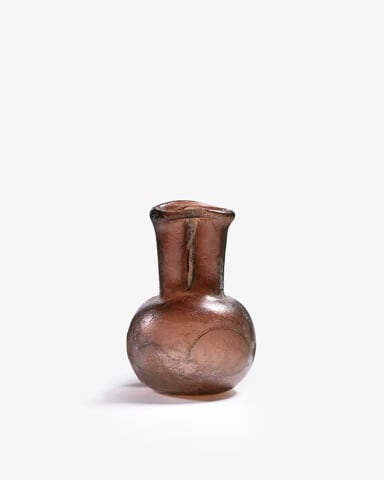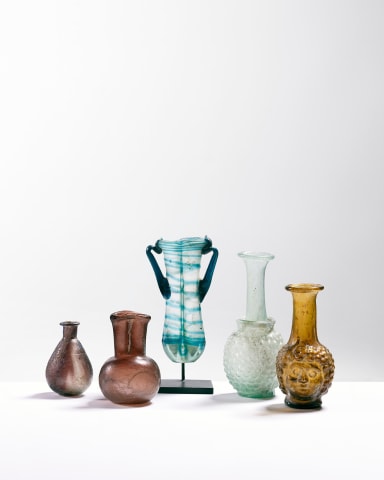86. Roman twin-necked bottle, Eastern Mediterranean, c.3rd-4th century AD
Glass
Height: 8.9cm, diameter: 5.9cm
11602 IVP
%3Cdiv%20class%3D%22title_and_year%22%3E%3Cem%3E86.%20Roman%20twin-necked%20bottle%3C/em%3E%2C%20%3Cspan%20class%3D%22title_and_year_year%22%3EEastern%20Mediterranean%2C%20c.3rd-4th%20century%20AD%3C/span%3E%3C/div%3E%3Cdiv%20class%3D%22medium%22%3EGlass%3C/div%3E%3Cdiv%20class%3D%22dimensions%22%3EHeight%3A%208.9cm%2C%20diameter%3A%205.9cm%3C/div%3E%3Cdiv%20class%3D%22price%22%3E%C2%A3%201%2C600%3C/div%3E
Free-blown in translucent purple glass, a few areas showing the remains of large opaque white flecks on the surface. The spherical body has a wide neck pinched vertically to create...
Free-blown in translucent purple glass, a few
areas showing the remains of large opaque
white flecks on the surface. The spherical
body has a wide neck pinched vertically to
create two tubes, the lip a little out-turned
then inward-folded. A break to the body
repaired, with a small lacuna restored.
This is a rare form, for which we have been
unable to find another example. The more
common variant has two separately blown
vessels fused together, so that both the body and
the neck are separated by a wall. The technique
used in this example is also unusual, where a
globule of molten glass was rolled in flecks of a secondary colour, here white. It was marvelled
then blown, leaving patches of the secondary
colour speckled over the surface.
Provenance
Private collection of K.A., Paris, France; acquired 1980s
Literature
For an example of the two vases fused together compare V. Arveiller-Dulong and M-D Nenna, Les Verres Antiques du Musée du Louvre, Vol.II (Paris, 2005), no.61



